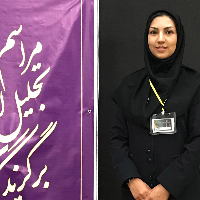Comparative Study on the Stucco Decorations of Two Monuments from the Greater Khorasan: Robat Sharaf and Faryoumad Mosque (Seljuq, Khwarazmian, Ilkhanid)
Khorasan’s architecture is famous for simple forms in the early Islamic period of Iran. In fact, from the 4th century AH decorations and Stucco decorations flourished; after simplicity of the Khorasan’s school, came an important decoration part in buildings of Iran. Stucco decoration, which was used in khorasan’s monuments, was a basic decorative element in the monuments such as the Seljuq-era Robat Sharaf and Faryoumad mosque that is attributed to the Saljuq, Khwarazmian and Ilkhanid periods. The similarities and differences of the decorations of these two monuments in the Great Khorasan have always been appealing to the experts. In this research, I tried to answer the questions regarding the similarities or differences of the stucco decorations in Robat Sharaf and Faryoumad in terms of types of decorations and their compositions. In this study, features and changes in stucco decorations from the Seljuq to the Ilkhanid periods are investigated using descriptive-analytical methods as well as comparative analysis of two monuments in the Greater Khorasan. Literature review and field survey were the methods of data collection. Due to the importance of these two monuments from Khorasan; those are selected as criteria and indicators of changes occurred in the decorative style of the Khorasan school. Comparative studies indicated that stucco decorations in Robat Sharaf are almost formed in “low relief” and “medium relief” while Faryoumad has “high relief” decorations. A combination of bricks and stucco motifs covers most parts of Robat Sharaf, in contrast, stucco is the common technique used to cover interior surfaces of Faryoumad. In fact, in Faryoumad the bricks had been covered with gypsum. Also, Faryoumad has muqarnas which has been decorated by stucco with different patterns in each “Tas”. “Ajed-e Kari” or honeycombed pattern was a common technique in the Seljuq and Ilkhanid stucco decorations, but there is merely one place that was decorated by honeycombed patterns in Rabat Sharaf, in contrast, this technique has been used in a great extent in Faryoumad stucco decorations. In terms of design, vegetative patterns covered a great extent of surfaces of Robat Sharaf which were designed in spiral compositions. In comparison, wavelike composition of vegetative patterns, or a combination of the wavelike and spiral patterns, including arabesque and “Ḵatāiee” (floral motifs resembling blossoms) motifs were used in Faryoumad. These combinations are symmetric in two or three layers in Faryoumad, but Robat Sharaf’s vegetative patterns, except one case, are in one layer and mainly include arabesques. Overall, comparison of motifs indicate that arabesque decorations are widespread in Robat Sharaf and there is one complicated geometric pattern, but sophisticated geometric patterns and inscriptive ornaments are widespread in stucco decorations of Faryoumad. In fact, geometric patterns in Robat Sharaf’s decorations, known as “Kaluk-band”, were mainly used between the bricks. They were simply designed and dressed with arabesque patterns in some spaces. In contrast, geometric patterns were elaborated and dressed with floriated ornaments (mainly Ḵatāiee motifs) of great variety in Faryoumad stucco decorations. Stucco ornaments in Robat Sharaf include knotty inscriptions in Kufic in mihrabs as well as one Thuluth inscription in the southwest Ivān. In contrast, Kufic and Thuluth inscriptions were used in various forms in Faryoumad including arabesques and floriated ornaments behind the inscriptions (in two or three layers). On the whole, Faryoumad has more than 12 different inscriptive ornaments which make it unique in this regard and in terms of stucco decoration. The colors used in two monuments are not completely intact and most of them have deteriorated. Considering the remaining colors on the surfaces, three colors including blue, white and black are commonly used in both buildings. These colors were used in similar areas, for example, blue was used in backgrounds to induce greater depth while white was used in upper areas to intensify the relief. In addition, yellow color was only observed in Robat Sharaf, while red and green colors have been used in Frayoumad. Results show that stucco decorations of Robat Sharaf and Faryoumad are similar in terms of techniques, patterns and motifs, but differ in some details, which represent the advancement and development of stucco arts throughout the above-mentioned centuries. In Faryoumad Jame mosque, high relief stucco has been added to the remaining Seljuq techniques. In the Seljuq style of decoration, brick and stucco were used in combination, but in the Ilkhanid art the method changed and gypsum became the main element for covering the bricks and decorations. Motifs are commonly vegetative in Robat Sharaf’s stucco decoration, while in Faryoumad, a combination of vegetative and geometric motifs were mainly used, meanwhile combination of geometric patterns with inscriptions gained more prevalence. The geometric knot is one of the prevalent patterns in Ilkhanid stucco decorations as well. In conclusion, motifs in Faryoumad are more complicated and more delicate than the motifs in Robat Sharaf, thus motifs in combination with decorated inscriptions have created more enriched, multi-layered surfaces.
- حق عضویت دریافتی صرف حمایت از نشریات عضو و نگهداری، تکمیل و توسعه مگیران میشود.
- پرداخت حق اشتراک و دانلود مقالات اجازه بازنشر آن در سایر رسانههای چاپی و دیجیتال را به کاربر نمیدهد.



